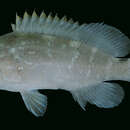Biology
provided by Arkive
The dusky grouper is a protogynous hermaphrodite, meaning that it matures as a female but later develops into a male as it grows larger and older (5). Sexual maturity is attained fairly late, when females are around five years of age, while sex reversal of females into males takes place between the 9th and 16th year, peaking at 12 (1) (5). The grouper usually leads a solitary and relatively sedentary life, except during the breeding season when small clusters of a few tens of individuals form at specific spawning sites (1) (5). The spawning season in the Mediterranean is from June to September (5), mating is polygynous and aggregations generally have a female bias of around seven females to each male (1) (5). During this period, dominant males establish territories and demonstrate strong territorial behaviour, acting aggressively towards neighbouring males and smaller females (1) (7). The maximum reported age of a dusky grouper was about 50 years (2).
Diet consists of crustaceans, molluscs and fish, with diet varying with body size (8). While younger, smaller groupers feed primarily on crustaceans, larger individuals feed on a greater proportion of fish, with the majority being reef-associated species (8) (2).
Conservation
provided by Arkive
Spearfishing of this species has been banned since 1993 in France (Mediterranean coast only), with evidence of small recoveries in this area (1). A number of Marine Protected Areas have also been established, where the habitat of the fish is protected or where fishing is prohibited (1) (9). In South Africa, the dusky grouper is part of a 'restricted group' of species governed by a bag limit of five fish a day (1). Additionally, the dusky grouper was recently added to the endangered teleost list in Annex 3 to the Berne Convention (1996), under which management measures must be planned and aquaculture maintaining and breeding techniques developed, in order to increase and repopulate endangered stocks (5). Unfortunately, this fish does not adapt well to living and reproducing in aquariums (2), and research into successful husbandry techniques is therefore ongoing (5).
Description
provided by Arkive
Jacques Cousteau reportedly said that groupers were the strangest creatures he had come across at sea (3). The dusky grouper is an extremely large fish with an oval body, big head, wide mouth and protruding lower jaw used to catch its prey (3) (4). Covered with small scales, the base colour of this sizeable fish varies but is generally a grey-brown colour with mottled pale markings (3) (4). Indeed, the Latin name, Epinephelus, loosely translates to 'with clouds on it', referring to these distinctive pale blotches (3). Males display a conspicuous silver streaked pattern during reproductive activity (5).
Habitat
provided by Arkive
A bottom-dwelling inhabitant of rocky reefs from the sea-surface up to 300 m in depth (1), often near Poseidonia sea grass (3). Juveniles are generally found closer to shore than adults, in rocky tidal pools (2) (6). In protected areas (no fishing), both adults and juveniles inhabit shallow waters, but depth range of juveniles is narrower (up to 20 m depth) than depth range of adults (11).
Range
provided by Arkive
Wide-ranging, occurring in the Mediterranean Sea and Eastern Atlantic from the British Isles round to the southern tip of Africa, and in the Western Indian Ocean, around southern Mozambique (1) (5). Also in the Western Atlantic, in waters around Southern Brazil, Uruguay and Argentina (2) (10).
Status
provided by Arkive
Classified as Endangered (EN A2d) on the IUCN Red List 2004 (1).
Threats
provided by Arkive
As a popular food fish, the primary threat to the dusky grouper is over exploitation from commercial fisheries across its range (1), although adult fish are also caught as trophies, particularly by spearfishing (9). Over-fishing and spearfishing have caused a dramatic decline in numbers over the last few decades, leaving dusky grouper populations seriously depleted, mainly in the north-western Mediterranean (5). The slow growth rate, late onset of maturity and complex reproductive biology of this species compound these threats by making it harder for it to withstand or recover from high fishing pressure (1). The fact that it also forms spawning aggregations, combined with its large size, makes this fish particularly easy to catch, and therefore vulnerable to over-harvesting (1). Indeed, despite insufficient data from many range countries, alarming declines have been recorded in Europe and the Mediterranean (mainly north-western), and there are also reports that spawning aggregations are being specifically targeted in Brazil (1).

